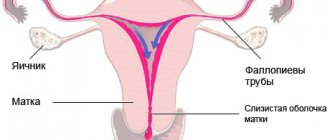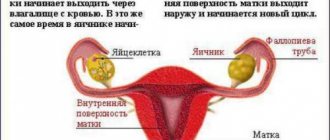How our body functions and what changes occur in it every month is always interesting. Especially during the period when we are pregnant or hope to become pregnant. We almost certainly never monitor our condition as carefully and closely as during the period when we hope to become pregnant. From feeling tired to feeling slightly nauseous, the smallest symptoms are studied and tested for their significance. In this article, we will look at some of the most common problems associated with implantation bleeding. This problem is frightening and confusing if the desired pregnancy has already occurred.
Thus, let's try to figure out what are the symptoms and signs of implantation bleeding, how to recognize the earliest signs of implantation and pregnancy? This self-control may be much stronger in people undergoing assisted fertility treatment, which is understandable. In this context, we will look at whether and how to expect any different implantation symptoms during pregnancy.
Content:
- Determination of intermenstrual bleeding in the middle of the cycle
- Types of intermenstrual bleeding
- Causes of bleeding and menstruation in the middle of the cycle
- Diagnosis of bleeding in the middle of the cycle
- Treatment and prevention of bleeding in the middle of the cycle
- Poor blood flow during pregnancy
Many women experience menstruation in the middle of their cycle at least once in their lives.
Naturally, an irregular menstrual cycle causes anxiety in women. Such disorders can occur in teenage girls and women of reproductive age. Often, spotting in the middle of the cycle is not a symptom of any disease and is considered normal. But sometimes the appearance of bleeding between periods can be a sign of serious gynecological diseases.
We care about your health
The reasons why a woman may experience bleeding from the uterus, vagina or other part of the reproductive tract, which prevail in different age groups, are different. Regardless of age, their danger lies in the occurrence of anemia (anemia), if blood loss is large enough and bleeding occurs regularly. If a woman is not pregnant and is not in labor, then the following types of bleeding can be distinguished, the source of which is the uterus:
- Dysfunctional bleeding in girls - occurs at a young age, a little after menarche, due to hormonal disruption of the ovaries
- Dysfunctional bleeding in women of reproductive age requires increased attention from a doctor, as it can serve as a harbinger of infertility.
- Menopausal bleeding occurs as a result of hormonal changes in the female body and may indicate a proliferative process, both benign and malignant. Most often it is benign: the appearance of polyps, myomatous nodes due to hyperestrogenemia (excess of the female sex hormone estrogen)
- Bleeding that occurs in postmenopause occurs some time after the onset of menopause, during which there was no bleeding from the genital tract. They may be a symptom indicating the process of tumor formation in the female reproductive organs.
- Postcoital bleeding is a special type of uterine bleeding that occurs after intercourse. It can be based on different reasons, both formidable and not posing a danger to a woman’s health.
Based on the moment at which bleeding from the genitals was detected, they can be classified into menorrhagia: this is the name for bleeding that coincides with menstruation, but the volume of blood lost clearly exceeds normal; as well as metrorrhagia: such bleeding does not coincide with the beginning of the menstrual cycle, but is noted by a woman before or after her menstrual period.
It is also worth noting three conditions that require immediate, urgent, prompt seeking of medical help
- A) Bleeding from the genital tract that occurs during pregnancy. It is important to note that such bleeding can rapidly increase in speed and lead to serious complications for both the fetus and the expectant mother.
- B) Bleeding that does not stop for a long time, which is accompanied by symptoms of anemia. The latter include pallor of the skin, decreased blood pressure, dizziness when trying to stand up or even sit down, constant headaches, a rare and weakened pulse in the radial arteries (on the wrist), and fainting.
- B) Internal bleeding. You should think about it if the bright symptoms of anemia are combined with the absence of visually recognizable blood discharge from the genital tract, especially if the patient also has a feeling of severe pain in the abdomen, and its anterior wall is very dense to the touch, board-shaped.
Uterine bleeding in women during the reproductive period
Many women suddenly notice bloody vaginal discharge that occurs between periods, or an excessive increase in the latter. If spotting, a small amount of discharge occurs at the time of ovulation (the release of an egg from a ruptured ovarian follicle), usually on the 14-18th day of the cycle, depending on its duration for a particular woman (28-32 days), then this should be considered normal . However, severe sudden bleeding should alert a woman, as it may indicate a gynecological pathology. If metrorrhagia that suddenly arises intensifies or simply does not end for a long time, then you need to consult a doctor who will stop the bleeding and also prescribe the necessary examinations to understand the reasons for its occurrence.
In addition to ovulation, the cause of uterine bleeding that occurs between two adjacent menstruation can be sudden changes in the amount of the female sex hormone estrogen in the blood, which is produced by the ovaries, any pathological process in which can cause the above-described manifestation. In addition, the basis of such metrorrhagia may be the end or beginning of the use of hormonal contraceptives, a significant decrease in the level of thyroid hormones, the use of emergency contraceptives, as well as other medications that somehow contain estrogen. In addition, bleeding between menstruation may be due to an infectious, tumor process of the genital organs or trauma, miscarriage, or the consequences of recent gynecological manipulations.
Treatment of the bleeding described above is prescribed according to the main reason due to which they occurred. If metrorrhagia is caused by a gynecological disease, then properly selected treatment for this disease will also stop bleeding.
Uterine bleeding in young girls
Bleeding from the genital tract that occurs in girls aged 12-18 years is called pubertal or juvenile. If such bleeding is severe, then there may be a threat to the health and life of a teenage girl, and therefore it is necessary to quickly consult a doctor who can prescribe adequate treatment so that this bleeding does not progress into the reproductive period, in which, in this case, it will increase danger of infertility for this patient. Quite often, juvenile metrorrhagia occurs in the winter-spring period due to a lack of vitamins and microelements in the girl’s body. Often the main cause can be stress, infectious processes or unhealthy diet. Most often, in the puberty period, bleeding in girls occurs after menstruation has been delayed (several weeks), and lasts more than seven days, sometimes increasing in intensity, sometimes decreasing, which can ultimately lead to large blood loss and anemia. This process needs to be stopped, and therefore it is necessary to contact an obstetrician-gynecologist immediately.
At the same time, both sudden and severe bleeding and prolonged and sluggish bleeding can lead to anemia. The symptoms of anemia are similar regardless of the cause that caused it: pale skin, weakness, dizziness when trying to sit or stand, drop in blood pressure, short-term loss of consciousness.
If a girl stops metrorrhagia on her own, she still needs to see a doctor, since the goal of treatment, in this case, will be to prevent anemia and a terrible complication - hemorrhagic shock.
Menopausal uterine bleeding
It is impossible to ignore the discharge of blood from the genital tract during menopause, as it can be a symptom of a pathological process, even uterine cancer. For many women, menopause is quite difficult. Along with uterine bleeding, surges in blood pressure, mental disorders, and metabolic disorders can occur.
Typically, the cause of menopausal bleeding from the genital tract is massive hormonal changes in a woman’s body, but they can also indicate tumor growth. Menopausal bleeding can be classified into:
- Metrorrhagia in premenopause
- Metrorrhagia in postmenopause
During the premenopausal period, bleeding from the reproductive tract most often occurs due to improper production of sex hormones due to disorders associated with the ovulation process, which, in turn, leads to changes in the change in the functional layer of the endometrium (epithelial lining of the uterus). Such bleeding may recur over several years with varying strength and frequency. Anemia in this case occurs infrequently, compared to teenage girls, however, if it occurs, it can be combined with uterine fibroids or with more complex and dangerous pathological processes in the female body.
Bleeding occurring in the postmenopausal period is the most dangerous, as it requires an immediate diagnostic search to exclude malignant neoplasms. Such metrorrhagia is an indication for diagnostic hysteroscopy (curettage of the uterine cavity and cervical canal).
Postcoital bleeding
If bleeding occurs in a woman immediately after intercourse, then it is called post-coital (coitus. Sin.: penetration, copulation, copulation, sexual intercourse). Such bleeding from the genital tract can be caused by a number of reasons:
- Mechanical trauma to the genital tract
- Sexually transmitted diseases (often chlamydia)
- Inflammatory diseases of the reproductive tract (vaginitis - in the vagina, cervicitis - in the cervix, etc.)
- Erosions and polyposis (require surgical treatment)
- Due to the use of certain medications, including hormonal
- Dysplastic changes (replacement of the epithelium with the wrong one for a given part of the reproductive tract) up to the tumor process
If bleeding is accompanied by severe pain and occurs suddenly during or after copulation, then it is necessary to call an ambulance, because the situation can be life-threatening. In this case, you need to pay attention to the symptoms in case the woman has internal bleeding, which may be accompanied by acute pain in the abdomen, groin, lower back, weakness, dizziness, fainting, profuse sweating (“cold sweat”).
Timely consultation with a doctor usually contributes to a quick cure.
Metrorrhagia after medical abortion
Typically, bleeding that occurs after a medical abortion stops in most women during therapy. And the cycle is completely normalized within 1-2 months. However, if, due to metrorrhagia after an abortion, two sanitary pads are completely soaked within one hour, then the bleeding should already be considered severe and requiring immediate intervention by a gynecologist.
Treatment of bleeding from the reproductive tract
The goals of treating metrorrhagia usually come down to stopping the bleeding itself and replenishing the lost blood volume, finding and eliminating the already found cause of metrorrhagia, preventing recurrence of bleeding and treating its consequences (anemia, hemorrhagic shock).
Uterine bleeding should be treated taking into account its causes. Often the bleeding itself stops when its cause is eliminated surgically or conservatively. Therapy should be comprehensive: hormonal, symptomatic, restorative (promotes the restoration of the female body). Treatment is usually based on hormonal therapy and symptomatic therapy - drugs that increase blood clotting and uterine contraction. In addition to the conservative approach, a surgical approach is often used: this occurs if the bleeding is quite severe and/or prolonged. Such treatment usually begins with diagnostic hysteroscopy.
It should be remembered that contacting a gynecologist should be an indisputable and indispensable component of the treatment of uterine bleeding. There should be no talk of self-medication, because if the cause of the bleeding is serious enough, the latter can cost the woman her health, and often her life itself.
To prevent uterine bleeding, every woman should visit a gynecologist twice a year for examination. In this case, early diagnosis of diseases associated with the reproductive tract will become possible, which will allow for quick and gentle treatment without waiting for dangerous bleeding.
Determination of intermenstrual bleeding in the middle of the cycle
Menstruation is one of the phases of the menstrual cycle of the female body, characterized by the release of blood from the vagina. The beginning of the menstrual cycle is counted from the first day of menstruation.
Sometimes it can be difficult to distinguish dysfunctional uterine bleeding from normal menstruation. Many girls do not remember when their menstrual cycle began and do not know how to calculate their menstrual cycle, so they may mistakenly think that menstruation came earlier or later than expected. For each woman and girl, the duration of the monthly cycle is individual
How to calculate the monthly cycle? It is not difficult. The easiest way is to keep a monthly calendar. It needs to mark 1 day of the onset of menstruation and 1 day of the next menstruation. The number of days between them will be the duration of the menstrual cycle. You need to know that normal menstruation lasts 2-7 days, and the normal menstrual cycle is 21-35 days. The most optimal duration of the monthly cycle is 28 days. Women who experience an irregular menstrual cycle should consult a gynecologist.
Ovulation is the process of the release of a mature egg from the follicle. In women with a normal monthly cycle, ovulation occurs approximately on the 14th day from the start of menstruation. With an irregular menstrual cycle, it may occur earlier or later than this time. After ovulation, the level of estrogen in the female body decreases, and bleeding does not occur because the corpus luteum maintains hormonal balance. A sharp increase or decrease in the level of the hormone estrogen during ovulation can provoke uterine bleeding between, before and after menstruation, and this is not a deviation from the norm. This phenomenon is observed in 30% of women.
Symptoms
When diagnosing metrorrhagia, the symptoms that first of all pay attention to are bloody discharge from the genital tract that does not correspond to the date of expected menstruation or the period of a woman’s life (menopause, pregnancy). They can be of varying abundance (both spotting and large volumes with massive blood loss).
Heavy or frequently recurring uterine bleeding invariably leads to chronic anemia (decreased hemoglobin levels in the blood).
Symptoms of anemia appear depending on its severity:
- pale skin;
- weakness;
- fast fatiguability;
- dizziness;
- drowsiness;
- tachycardia (increased heart rate);
- loss of consciousness.
Types of intermenstrual bleeding
Intermenstrual bleeding often occurs 10-16 days after the end of the last menstrual period. They are not very abundant and last from 12 to 72 hours. But if the bleeding lasts longer or gets worse, consult your gynecologist.
Spotting in the middle of the cycle is more common than intermenstrual bleeding. A woman's vagina comes out with a little blood that can barely be seen on the toilet paper. This is usually mucus that has a pinkish color. Such discharge appears approximately 14 days before the onset of menstruation and is not a pathology. Intermenstrual bleeding indicates that the egg is ready for fertilization.
Frequent periods can also occur with proyomenorrhea (short monthly cycle). Periodically appearing and usually not intense bleeding lasts 2-3 days. Such spotting is caused by premature rejection of the uterine mucosa due to a decrease in estrogen production in the middle of the menstrual cycle.
What is implantation bleeding?
About 30-40% of women experience slight blood loss after the embryo implants in the uterus. This phenomenon is known as implantation bleeding. Since this happens early in your cycle, it may even be the first sign you realize you're pregnant. Bleeding usually occurs in the first weeks of pregnancy, since the uterus is an organ rich in blood vessels that can easily become damaged. When the embryo sticks to the inner wall of the uterus, the small veins and arteries that normally connect to the endometrium rupture and this can cause bleeding. If this occurs, usually 6-10 days after fertilization, it usually coincides with the theoretical date of menstruation and can therefore be confused with the onset of menstruation. There is no set pattern, and implantation bleeding may occur in one or all of a given person's pregnancies.
Causes of bleeding and menstruation in the middle of the cycle
Often, an irregular menstrual cycle is observed in teenage girls, since at their age the hormonal background has not yet become stable. If, after 2 years after the first menstruation, girls still have periods in the middle of the cycle, then you need to consult a gynecologist who will prescribe treatment to normalize the menstrual cycle.
Constant strong stressful situations, smoking, and alcohol have a bad effect on the body. As a result, women experience irregular menstrual cycles and may experience periods mid-cycle. Such phenomena often occur in women with frequent dysfunction of the genitourinary system; bleeding in such cases is more profuse.
If you move to another city, country or go on vacation to the sea, be prepared for the fact that the start of your menstrual cycle may occur earlier than usual and your period may begin in the middle of the cycle. After all, climate change is also stressful for the body, and it needs time to get used to it.
There can be many factors that provoke bleeding between periods. The main ones:
- pathologies of the endocrine system (diseases of the thyroid gland and adrenal glands, etc.);
- uterine fibroids;
- hormonal disbalance;
- miscarriage;
- the presence of an intrauterine device;
- gynecological procedures (cauterization or cervical biopsy);
- taking certain medications and contraceptives;
- vaginal trauma and vaginal infections.
- depression and stress.
- infectious diseases;
- poor blood clotting;
- deficiency of vitamins K and C;
- inflammation of the urogenital system;
- pathologies of the development of the internal genital organs of a woman (uterine inflection);
- ovarian tumors and cysts;
- chronic diseases (heart, kidney, liver and metabolic disorders);
- physical injuries.
Also, intermenstrual discharge may indicate such serious problems of the female genital area as uterine cancer, polyps and fibroids of the uterus, and the presence of adhesions.
Causes (metrorrhagia and menorrhagia)
When diagnosed with metrorrhagia, the reasons for the formation of such a pathological condition can be different:
- Pathologies of the brain, namely its parts that participate in the cascade of hormonal regulation of the ovarian-menstrual cycle (hypothalamus, pituitary gland).
- Pathological conditions of the ovaries (ovarian cysts, polycystic disease, luteal phase deficiency).
- Pathologies of the uterus itself (fibroids, polyps and endometrial hyperplasia).
- Diseases of the thyroid gland in the form of hypo- or hyperthyroidism.
- Pathologies of the adrenal glands.
- Coagulopathic conditions (hemophilia, idiopathic thrombocytopenic purpura).
- Taking medications that impair blood clotting.
Diagnosis of bleeding in the middle of the cycle
First of all, to diagnose the causes of intermenstrual bleeding, a gynecological examination is necessary. In addition, you must undergo the following examinations:
- cytological studies of aspirate from the uterine cavity;
- Ultrasound of the pelvic organs;
- study of the hormonal background of the body;
- thyroid examination;
- hysteroscopy and curettage of the uterine cavity and cervical canal;
- histological examination of scrapings obtained from the uterine cavity and cervical canal.
Also, if necessary, the gynecologist can prescribe a study of the pituitary gland using magnetic resonance imaging, radiography, computed tomography. Sometimes the brain is also examined using these methods.
Prices for services
| Name of service | Price |
| Primary appointment (examination, consultation) with an obstetrician-gynecologist | 1800 rub. |
| Repeated appointment (examination, consultation) with an obstetrician-gynecologist | 1500 rub. |
| Appointment (examination, consultation) with an obstetrician-gynecologist of a leading specialist, primary | 2300 rub. |
| Repeated appointment (examination, consultation) with an obstetrician-gynecologist of a leading specialist | 2000 rub. |
Treatment and prevention of bleeding in the middle of the cycle
Treatment methods for bleeding in the middle of the cycle depend on the causes of this deviation, as well as on the woman’s age. Treatment can be conservative or surgical. In case of ovulatory bleeding, conservative treatment is carried out. For anovulatory bleeding (not associated with ovulation), both surgical and conservative treatment may be necessary. The exception is anovulatory bleeding in adolescents, when surgical treatment is used only as a last resort.
Conservative treatment is based on the use of hormonal drugs to normalize the irregular menstrual cycle and stop bleeding. Your doctor may also prescribe sedative medications to treat untimely periods caused by stress.
For severe bleeding, women are prescribed iron supplements. It should be remembered that a balanced diet (including foods such as beef, legumes, liver, vegetables and fruits), proper rest and sleep will help restore health faster.
To prevent bleeding in the middle of the cycle, you need to: regularly see a gynecologist, refuse abortions, have a regular sex life, control your weight, play sports, give up bad habits.
If you notice that your period starts earlier or later each time, please consult a qualified healthcare professional. Untimely treatment of pathologies that cause disruption of the monthly cycle and bleeding can lead to anemia, infertility, and cervical cancer.
Bleeding while taking birth control pills - causes
Hormonal contraception is a convenient and effective form of contraception. However, like any method, it has advantages and disadvantages. One of these disadvantages is the possibility of sudden bleeding and spotting, especially when starting to use birth control. Every patient who begins using hormonal contraceptives should be informed of this risk. Problems should disappear as the body gets used to a constant dose of hormones.
Bloody issues
If spotting and breakthrough bleeding do not stop during the first three months of taking birth control pills, your gynecologist may decide to change the type of pill or method of hormonal contraception. It should be remembered that bleeding during contraception can also occur when a woman has an intrauterine hormonal device, such as Mirena.
Usually monthly bleeding is a temporary effect and lasts up to 6 months, over time it should also become less burdensome, after a year it may not exist at all - this is the effect of a hormone released, for example, from Mirena, which directly affects the endometrium.
Bleeding and spotting while taking birth control pills can also be caused by other factors, such as:
- missed daily dose;
- diarrhea and vomiting, which reduce the level of hormones in the blood serum;
- taking medications or herbs that reduce the effect of hormones contained in tablets;
- smoking cigarettes;
- incorrectly selected dose of hormones in tablets (sometimes you need to change tablets to tablets with a higher dose of estrogen).
Incorrect dose of hormones in the pills
If bleeding while taking birth control pills is due only to the fact that the woman has problems taking the drug regularly, it is worth considering other forms of hormonal contraception that are long-term. A good solution might be, for example, a contraceptive patch that is placed on the arm, back, buttock or thigh every week.
Poor blood flow during pregnancy
During pregnancy, it is extremely important to continuously monitor the state of the maternal body of the mother and the baby, it is important that they perform all vital functions. One of the most significant studies is the analysis of blood flow in the arteries of the uterus, the woman’s umbilical cord, as well as cerebral vessels and the fetal aorta. The main causes of perinatal morbidity and mortality include disorders of the uteroplacental blood flow of 1A, 1B, second and third degrees.
Blood flow in the placenta
The placenta, in which the fetus is located, supplies the embryo with nutrients, as well as oxygen from the mother’s blood; it also removes waste products from the child’s body. It is this organ that unites two rather complex vascular systems - the female, which connects the vessels of the uterus and placenta, and the fetal, which passes into the umbilical arteries and leads to the child.
The circulatory systems mentioned above are separated by a membrane, which does not allow maternal and child blood to mix. The placenta is a kind of barrier that is resistant to numerous harmful substances, as well as viruses.
Often, for completely different reasons, placental insufficiency may appear, which inevitably affects the performance of transport, metabolic, trophic, endocrine and other vital functions of the placenta. In this condition, the metabolism between the maternal and child organisms deteriorates significantly, which is fraught with various consequences.
What are the causes of impaired placental blood flow?
Poor circulation in the uterine cavity can be caused by pneumonia, increased blood pressure, various intrauterine infections, as well as insufficient oxygen supply to the child’s body (hypoxia).
To diagnose the blood flow system in modern obstetric practice, three-dimensional ultrasound (so-called Doppler ultrasound) is used, with which the vessels are visible in a 3D (three-dimensional) image. With the help of this diagnostic technique, there is a prospect of diagnosing retroplacental bleeding and assessing cardiac malformations by monitoring blood flow. This technique is irreplaceable, since with its help it is possible to examine defects even in the most microscopic vessels that form the microvasculature, to observe the peculiarities of the formation and development of intraplacental hemodynamics, and in addition to control the amount of nutrients, as well as oxygen, that should enter the fetal body . New prospects have opened up for the early detection of obstetric complications, and if treatment or correction is started without wasting time, then circulatory disorders and subsequent pathologies associated with it can be almost completely avoided.
Hemodynamic disorders during pregnancy
Hemodynamic disorders are divided into 3 degrees of severity:
1. 1st degree includes two subtypes:
- disturbance of patello-placental blood flow 1Is the mildest. Fetal-placental blood circulation is preserved with it. Intrauterine infections often lead to this problem;
- in degree 1B, uteroplacental blood flow is preserved, but fetal-placental pathologies appear.
2. Grade 2 is characterized by the presence of disturbances in both blood flow systems, however, these disturbances do not carry any fundamental changes. 3. In grade 3, uterine circulation disturbance causes defects in normal blood circulation at the level of the fetus.
In the case of the first degree of violations, timely detection and adequate treatment can avoid fetal death. In the case of the second degree, perinatal mortality is about 13.3 percent, in the case of the third - 46.7 percent. During Doppler diagnostics, it was revealed that treatment aimed at correcting placental insufficiency in women with third-degree uterine blood flow disorders was ineffective. In this situation, with conservative childbirth, perinatal mortality was 50 percent, then, thanks to a cesarean section, losses can be avoided. 35.5 percent of newborns are admitted to the intensive care unit with grade 1 blood flow disorders, 45.5 percent with grade 2, and 88.2 percent with grade 3.








